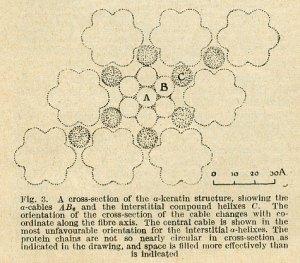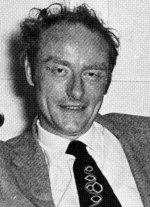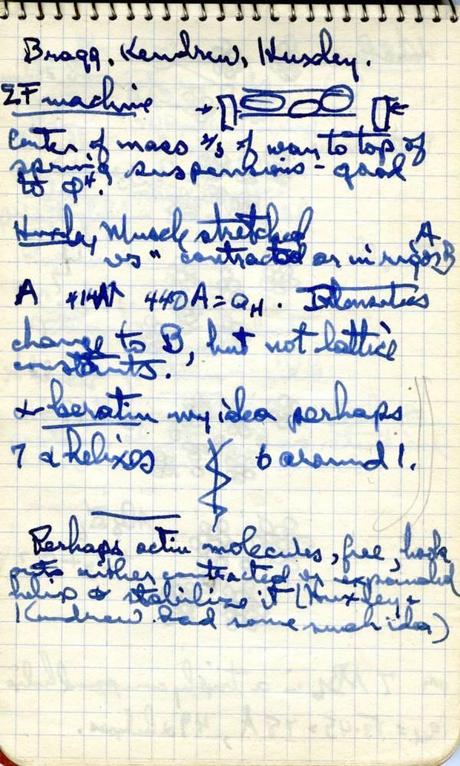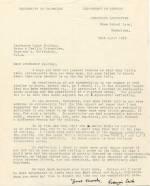
Coiled-coil illustration from Pauling and Corey’s Nature publication of January 10, 1953.
Within the overarching saga of the race for DNA between Linus Pauling’s Caltech lab and Sir William Lawrence Bragg‘s Cambridge lab, the Cavendish, there existed a small yet interesting story of controversy and intrigue: the case of the coiled-coils.
In August 1952, Linus Pauling visited England during the final leg of a larger European tour largely devoted to touting his important new discovery, the alpha helix. Lecturing about his proposed protein structure inevitably led to Pauling’s visiting all of the major centers for research in England that were focusing on proteins. One of these centers was the Department of Physics at Cambridge University – the Cavendish – directed by Bragg, a Nobel laureate and Pauling’s long-time scientific rival. While visiting the Cavendish, Pauling also met with a non-traditional graduate student with whom he had communicated only a few times, via letter. This student was Francis Crick, the British scientist who, together with his American colleague James Watson, would go on discover the double-helical structure of DNA the following year.

Francis Crick, 1955.
One afternoon during Pauling’s visit, Crick and Pauling shared a taxi cab as they traveled around the premises of Cambridge. During this jaunt, the two discussed several topics of mutual interest, including Pauling’s alpha helix. Eventually this conversation turned to an examination as to why Pauling’s model of the alpha helix lacked the 5.1 angstrom repeating turn (all helices, by definition, twist) found in x-rays of keratin, a fibrous protein structure that makes up the outer layer of human skin. Pauling’s model predicted a turn every 5.4 angstroms. This mystery had remained a thorn in Pauling’s model since his publication of the alpha helix a year prior.
During their cab ride, Crick is reputed to have asked Pauling about the possibility that alpha helices are coiled around one another. Pauling, according to a letter recounting the event, replied that he had, and that this reply marked the end of the discussion of coiled-coils between the two scientists. Crick, however, claimed in a later letter that the conversation was longer and more detailed. Whether or not the conversation was brief or of greater length, this was the beginning of a controversy.
His tour completed, Pauling returned to Caltech and renewed work on the angstrom reflection problem dogging the alpha helix. He and Robert Corey, the biochemist with whom Pauling and Herman Branson had collaborated to develop the alpha helix, soon found that if two to seven alpha helices were wound “like a piece of yarn around a finger, into a sort of coiled-coil” the resulting structure would match the 5.1 angstrom reflection found in x-rays of keratin. This addition to the alpha helix hypothesis built upon an undated idea of Pauling’s that was written down in a travel journal that he kept during the European tour. The notes describe a structure that Pauling named “AB6″ – six alpha helices (B6) coiled around a seventh (A).

Pauling’s first notes on what would later be described as “coiled-coils.”
Meanwhile, back at Cambridge, Peter Pauling – one of Linus and Ava Helen’s three sons – was working at the Cavendish as a graduate student alongside Crick and Watson, having arrived the same summer as his father. Peter told Crick – who was also working on “coiled-coils” of the alpha helix – of his father’s research in Pasadena. This news undoubtedly felt to Crick like Linus Pauling had built upon the ideas that Crick brought up in their conversation.
In a rush to be published first, Crick hurriedly finished his research and dashed off a note to the journal Nature in October 1952, only to discover that Pauling’s own manuscript had arrived just a few days before. However, in a surprise twist, Crick’s manuscript was published first, likely due to two factors: 1. Crick’s paper was shorter, and 2. it was sent with a cover letter from Max Perutz, a supporter of Crick and part of Bragg’s Cavendish team, requesting high-speed publication.
The following month, Pauling wrote a letter to Jerry Donohue, a former Caltech doctoral student who had worked with Pauling since the 1940s and was, at the time, working at the Cavendish on a Guggenheim Fellowship. The communication was in reply to a letter that Donohue had written to Pauling reporting on Crick’s Nature submission. In his reply Pauling explained that he remembered the conversation with Crick involving the alpha helix during the past summer. Cognizant of the controversy brewing over the provenance of the coiled-coil idea, Pauling specifically wrote that the conversation with Crick was brief.
A few months later, in March 1953, Pauling wrote a similar letter to Max Perutz, this one containing more detail on the matter. Pauling mentions in the letter that he had thought of Crick’s suggestion prior to their conversation, but had not fully fleshed it out; a claim perhaps supported by Pauling’s travel journal.

Pauling to Perutz, March 29, 1953.
Francis Crick was given a copy of Pauling’s letter to Perutz. In response, Crick recalled the taxi cab conversation as having been longer than Pauling remembered, and more in depth on the subject of the coiled-coils, thus leading him to the assumption that Pauling had built upon his ideas. This would have been fine, Crick wrote, had Pauling simply informed Crick so that the two scientists could publish simultaneously, giving credit where credit was due as well as bolstering each other’s work.

Crick to Pauling, April 14, 1953.
Crick did admit that Pauling’s paper was more detailed and thorough than was his own, and also came to different conclusions on key points. These factors were enough for both Caltech and the Cavendish to declare that Pauling and Crick had generated their ideas on coiled-coils independent of one other, if simultaneously.
